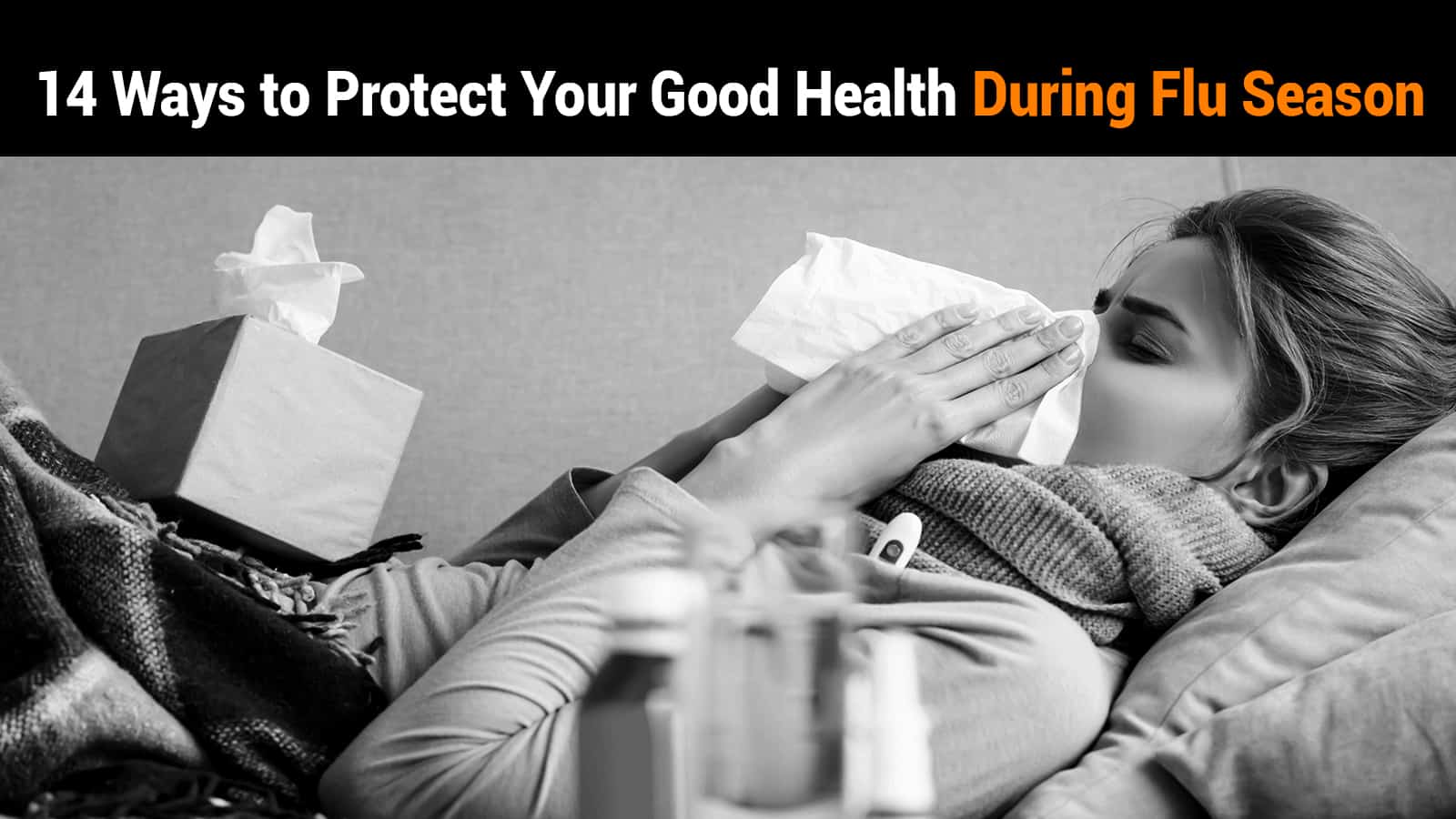Flu season comes around every year during the cooler weather of late fall and can last as late as April the following year. Its peak is between January or February, and its effects are felt around the country. There are six primary types of flu, or influenza as it’s medically called.
Knowledge, as they say, is power. And with symptoms that can range from mild to severe–or even life-threatening–we should all learn how to protect ourselves from infection.
The Primary Types of Influenza
Are you familiar with the various types of influenza that you can come in contact with during the flu and cold season? You might not have even heard of some of them as some are more common than others.
 • Influenza A
• Influenza A
This is the most common type of flu virus. Shockingly, it can be found in both animals and people. It’s the one that usually causes the most severe symptoms. Since this strain mutates rapidly, you must be careful to wipe down all surfaces an infected person touches.
Within this category, there are 198 subtypes and strains, and some are more severe than others. If you contract Influenza A, then you can expect to be sick for one to two weeks.
• Influenza B
While type B is not as expected, it has the same duration time of one to two weeks. It’s usually the strain that causes an epidemic, though it won’t cause a pandemic.
Type B is confined to only humans, and it’s generally weaker than Type-A. However, keep in mind that it can have some potentially severe side effects.
• Influenza C
Type C will cause seasonal flu epidemics, but it’s the least severe of all influenza strains. It can be dangerous to infants, the elderly population, and those who have weakened immune systems. It only lasts about 3-7 days, though it can last longer in those with other medical conditions.
It’s not uncommon to see influenza C coexist with a pandemic outbreak of influenza A. Since many view this as a mild respiratory illness, it comes across as nothing more than the common cold for most people.
• Influenza D
Influenza D was thought to be a strain that only affected swine and cattle. However, in 2011, the medical community conducted studies and theorized that it could be passed from animals to humans. The worldwide distribution of this flu strain is possible.
• H1N1 Swine Flu
Swine flu originated in Mexico in 2009. This deadly virus is a combination of three human types, as well as swine and bird flu. It’s a mutated part of influenza A, and it’s responsible for the first flu pandemic the world has seen in over four decades.
• H5N1 Bird Flu
The bird or avian flu is passed from birds to humans. Thankfully, it cannot be passed from person to person. If you contract this deadly form of influenza, your chances of survival are a mere 50 percent.
This is a severe type of flu that carries with it a high risk of severe complications. Many people experience multi-organ failure as well as the high mortality rates. New studies of the movement of this virus in Egypt show that there is a possibility of human-to-human transmission, though there is nothing definitive.
Protecting Yourself During Flu Season
It’s easy to see why protecting yourself is so essential during the cold and flu season. What may seem like a minor respiratory condition can be influenza C.
If you want to reduce the risk of you or your family getting sick this year, then here are 15 ways that you can help to safeguard your health.
1. Wash Your Hands More
You can never wash your hands too much. During the winter months, your hands may become dry and crack from the weather and hand washing.
You should always carry some lotion with you. Did you know that open wounds on your hands can increase your chances of getting sick?
2. Social Distance
Social distancing has become the new normal. When flu season rolls around, you want to stay far away from those who are infected.
The sad part is that you don’t know who is infected and who’s not. Stay at least six feet apart to ensure if someone should cough or sneeze; their germs won’t bother you.
3. Wear a Mask in Public
Masks help to protect you from germs you cannot see. If someone coughs or sneezes, then the chances of breathing in their germs increase when you are not adequately covered. If you’re going to wear a mask, make sure it covers your mouth and nose.
4. Cough or Sneeze Into Your Elbow
If you feel the need to sneeze or cough, do yourself and those around you a favor and cough into your elbow. Keep some tissues handy, too, as your sinus issues might scare someone trying to protect themselves.
5. Cover Your Ears, Nose, and Mouth When You Go Out
Invest in a lovely scarf so that you can cover your mouth, ears, and nose when you go outside. The cold air can wreak havoc on a weak immune system, and you need to keep these areas of entry warm.
6. Stop Touching Your Face
There are 101 reasons you should avoid touching your face, and one of them is you can get influenza during flu season. If someone sneezes on a box at the grocery store and you pick it up 10 minutes later, that virus is on your hands. You certainly don’t want to put it anywhere near your mouth or nose.
7. Avoid Shaking Hands
While it’s customary to shake hands for business and social interaction, just tell people you are not doing that during the flu season. Some celebrities like Howie Mandel have been very public about their germophobic nature, and they wouldn’t dare shake a hand. It seems that he wasn’t, maybe as zany as everyone thought.
8. Resist the Urge to Hug People
Even if your sweet mom or grandmother is visiting for the holidays, please try to avoid hugging. It’s not only for your protection but for theirs too. If they insist on a hug, then make sure you turn your face to the outside, away from theirs.
9. Carry Hand Sanitizer with You
Hand sanitizer is an everyday item that is carried with you these days. Make sure you have a bottle that has at least 90 percent germ-killing capacity. Remember that it cannot take the place of washing your hands with soap and water for 20 seconds, but it helps.
10. Beware of Doorknobs
There’s nothing worse than touching dirty doorknobs. Do you know how many times a doorknob in your place of employment is touched every day?
The germs on these surfaces are astronomical in numbers. Do yourself a favor and use a paper towel or the end of your shirttail.
11. Avoid Public Bathrooms–Especially During Flu Season
It’s never a good idea to hold your bladder unless you’re in the middle of the flu season. Public restrooms are a cesspool of germs and diseases.
If only everyone washed their hands, it would help a little. Sadly, many don’t wash their hands, and they carry germs from shopping centers and their home right along with them.
12. Never Drink or Eat After Anyone
It might be tempting to share a sip of cider with someone, but you must resist the urge. When you drink a beverage, your germs from your mouth go into that cup. Now, if you share it with someone else, then your germs also go into their mouth. It’s just not a good idea to eat or drink after any during anyone during the flu season.
13. Avoid Sugar
Did you know that sugar can weaken your immune system, making it harder to fight off illnesses? The winter months are notorious for sweet treats and other goodies, but you need to be careful and eat healthily. Allow yourself a few special things, but make sure your diet supports health and immunity.
14. Take Immune Boosting Vitamins
Lastly, the best thing you can do for your body this season is to load up on Vitamins C and D as well as zinc and garlic. The goal is to build your immune system so that if it encounters microscopic droplets from other people, it can fight off these foreign invaders. Do you have time to be sick this winter?
 Final Thoughts on Taking Precautions During Flu Season
Final Thoughts on Taking Precautions During Flu Season
Did you know that the U.S. Centers for Disease Control estimates that each person will get 2-3 colds each year? Sadly, almost 10 percent of the population will fight with influenza during the flu season.
It would help if you did whatever you can to protect yourself as some flu strains are deadly. While preventative measures won’t guarantee that you won’t get sick this year, it can reduce the risk of you contracting influenza. Safety and common sense are the keys to having a healthy, flu-free season ahead.




















